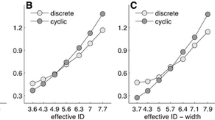Abstract
A traditional continuous Fitts' task may be described as a one-dimensional oscillation between two targets. The combination of two such oscillations along intersecting axes gives rise to a two-dimensional aiming task, allowing the study of the speed-accuracy trade-off in two-dimensional task space. In two experiments subjects were asked to draw as many ellipses as possible while passing through four targets, arranged around the extreme points of the two major axes of a model ellipse. In the first experiment, task difficulty was manipulated simultaneously along the two axes of the ellipse. Regardless of ellipse eccentricity and orientation, movement time (MT) was found to depend linearly on Fitts' index of difficulty (ID), which combines between-target distance and target width. In the second experiment, ID was manipulated independently for the short and the long axes of the ellipse. There was a strong linear relation between MT and ID averaged over the two axes, with the two independent measures of task difficulty exerting interactive effects on MT: the higher the ID on one axis, the smaller the effect of the ID on the other. The present results demonstrate that Fitts' law, only examinated so far in one-dimensional aiming tasks, generalises to two-dimensional task space.
Similar content being viewed by others
References
Abernethy B, Sparrow WA (1992) The rise and the fall of dominant paradigms in motor behaviour research. In: Summers JJ (eds) Approaches to the study of motor control and learning. North-Holland, Amsterdam, pp 3–45
Crossman ERF, Goodeve PJ (1963/1983) Feedback control of hand movements and Fitts' law. Q J Exp Psychol [A] 35:251–278 (Original work presented at meeting of Experimental Psychology Society, Oxford, England, July 1963)
Fitts PM (1954) The information capacity of the human motor system in controlling the amplitude of movement. J Exp Psychol 47:381–391
Fitts PM, Peterson JR (1964) Information capacity of discrete motor responses. J Exp Psychol 67:103–112
Guiard Y (1993) On Fitts' and Hooke's laws: simple harmonic movement in upper-limb cyclical aiming. Acta Psychol 82:139–159
Kelso JAS, Southard DL, Goodman D (1979) On the nature of interlimb coordination. Science 203:1029–1031
MacKenzie CL, Marteniuk RG, Dugas C, Eiske D, Eickmeier B (1987) Three dimensional movement trajectories in Fitts' task: implications for control. Q J Exp Psychol [A] 39:629–647
Meyer DE, Abrams RA, Kornblum S, Wright CE, Smith JEK (1988) Optimality in human motor performance: ideal control of rapid aimed movements. Psychol Rev 95:340–370
Saltzman E, Kelso JAS (1987) Skilled actions: A task dynamic approach. Psychol Rev 94:84–106
Schmidt RA (1988) Motor control and learning: a behavioral emphasis (2nd edn). Human Kinetics, Champaign, IL
Schmidt RA, Zelaznik HN, Frank JS (1978) Sources of inaccuracy in rapid movement. In: Stelmach GE (eds) Information processing in motor control and learning. Academic, New York, pp 183–203
Wann J, Nimmo-Smith I, Wing AM (1988) Relation between velocity and curvature in movement: equivalence and divergence between a power law and a minimum-jerk model. J Exp Psychol Hum Percept Perform 14:622–637
Welford AT (1968) Fundamentals of skill. Methuen, London
Woodworth RS (1899) The accuracy of voluntary movement. Psychol Rev [Mon Suppl 3] 3
Author information
Authors and Affiliations
Rights and permissions
About this article
Cite this article
Mottet, D., Bootsma, R.J., Guiard, Y. et al. Fitts' law in two-dimensional task space. Exp Brain Res 100, 144–148 (1994). https://doi.org/10.1007/BF00227286
Received:
Accepted:
Issue Date:
DOI: https://doi.org/10.1007/BF00227286




